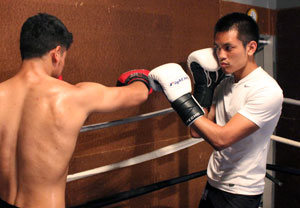
Learn how to deflect your opponent’s attacks using his own momentum to leave him open to your counter-punches. Here is the ultimate guide to parrying punches!
What is a Parry?
parry – a defensive movement to deflect a thrusting attack
The word “parry” comes from fencing. To parry an attack meant to deflect the attack by using your sword to divert the opponent’s sword in another direction.
Why Parry in Boxing?
In boxing, parrying is a beautiful defensive move that uses your opponent’s momentum against him. Parrying is a superior defensive move to blocking because it offers more protection while creating better counter opportunities using your opponent’s energy. The more your opponent overcommits into his punches, the more effective your parry will be. As you face stronger opponents, blocking becomes a less likely option. Blocking still absorbs partial damage whereas parrying can deflect the attack away entirely.
Parrying is superior to blocking, defensively AND offensively.
Parrying a punch allows you to defend against stronger punches, while setting you up for a better counter. Instead of absorbing your opponent’s power into your arm, you’re deflecting it elsewhere to make him off balanced and vulnerable. You’re also leaving your hands free to counter. Covering your face to block punches would have occupied your hands AND your vision.
After you’ve learned how to block punches, parrying becomes the next level of defensive skill.
How to Parry a Punch
You may have seen the parry before or had your trainer try to explain it to you. In case you didn’t, here it is in full color pictures and video. YAY!
Down Parry
The down parry is a simple downward slap of your palm over your opponent’s glove. The punch is deflected downwards away from your face giving you a counter opportunity over the top.
Down parry against the left jab.

Richard throws a jab at me.
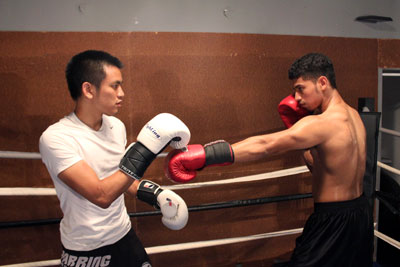
I parry the jab down with my right hand, opening my opponent for a counter jab, right, or 1-2.
(Keep your right hand as close as possible to your face.)
Using the Down Parry
The down parry is the easiest parry to learn. It’s effective against many punches and requires little movement. After you parry down an opponent’s punch, you can throw counters over the top. (Try this: If your opponent throws a 1-2, you can parry twice as you counter with a 2-1. Just slap his punches down and counter over the top!)
Side Parry
The side parry is a sideways push against your opponent’s glove. Side parries will deflect punches to the side as you counter and/or escape from the outside.
Side parry against the right hand
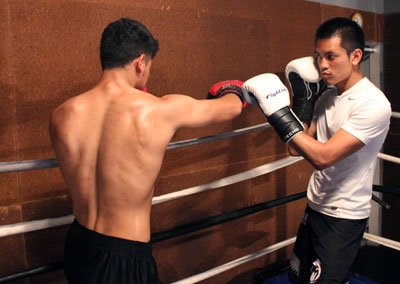
I parry the right hand to the side. I can counter with a left hook or pivot to the side to escape or get an angled counter.
Using the Side Parry
The side parry can be more effective than the down parry against stronger punches. Parrying down a hard punch might direct his punch to your body, still causing damage. By parrying the punch to the side, he will miss you entirely giving you more time to counter.
The side parry can be very tricky to use. The jab might be too fast to side parry whereas the right hand may be too risky to side parry (if you miss the glove, you take a big punch). Some fighters will prefer to deflect the right hand with their shoulder or their forearm instead of using the glove. I’m sure you’ve seen this “shoulder roll” technique used before by defensive wizards such as James Toney and Floyd Mayweather. Nonetheless the side parry is stil a beautiful defensive move to use once you have perfected it.
TIP: the side parry works beautifully against southpaws. Push the southpaw left to the side with your right hand, and follow up with a counter right or counter 1-2. (It also helps to slip your head to the right as you do the side parry.)
Forearm Parry
The forearm parry uses your forearms to deflect the punch upwards or to the side. A well-timed upwards bump of your forearms will send the punch up and over your shoulders. There are multiple variations for the left forearm and one variation for the right forearm.
Right Forearm Parry
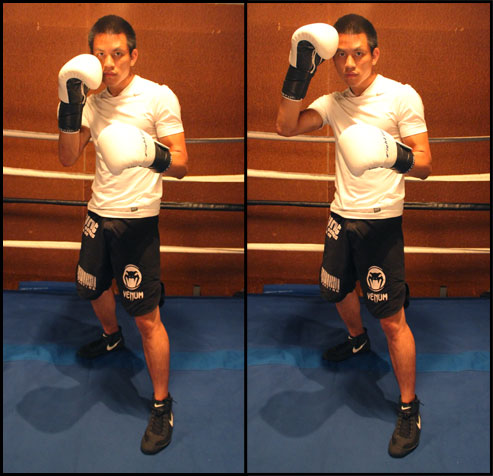
The right forearm moves up slightly to deflect punches upwards or to the side.
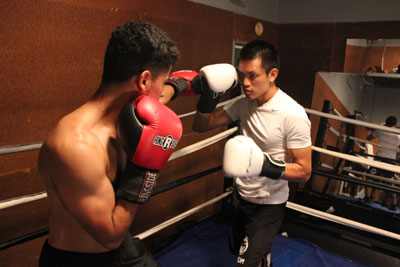
Deflect the jab off your forearm and counter with a jab, right, or counter 1-2.
Another way to use the Right Forearm Parry
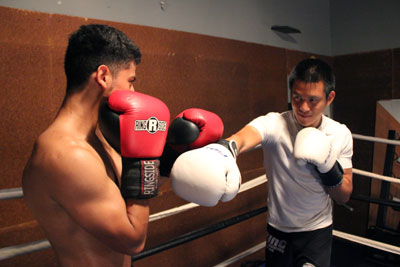
Sometimes when I miss a right cross…
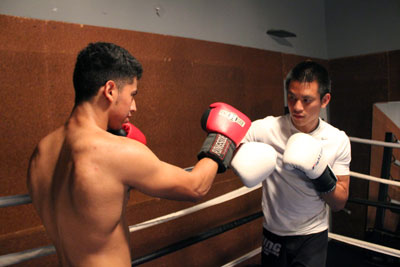
Oh crap! Here comes the counter right!
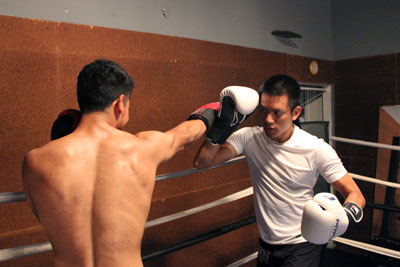
Instead of trying to cover my face, I pull my right hand upwards deflecting his counter as I attack with a left hook.
Left Forearm Parry – OUTSIDE

The left forearm moves up slightly to deflect right hands.
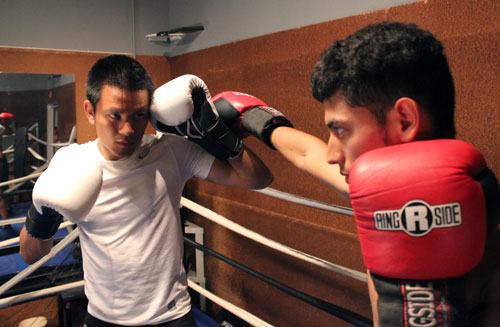
I deflect right hands to the outside opening the path for a counter jab, right hand, or 1-2.
Left Forearm Parry – INSIDE
For the inside forearm parry, roll away from the punch as you deflect it with the forearm.

Notice the two variations to this. You can look OVER the forearm or UNDER the forearm.
As one of my trainers Rick said, “Touch your ear or touch your forehead.”
(Thanks, Rick for showing me both of these!)
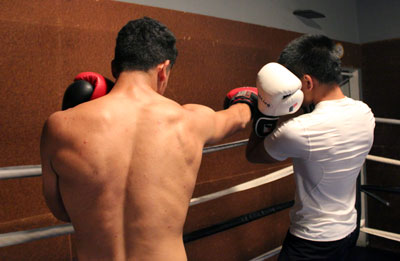
I roll to deflect the right hand to the side which sets up my counter right. I lean my body into my front foot to keep my opponent in range.
Using the Up Parry
You have to be careful for hooks that might come around your guard. The up parry works best for really straight punches. A friend of mine recommended to step in while parrying a right hand. He told me this shocked his opponents when he ended up inside their punch and landed devastating counters.
If you’re doing the left forearm INSIDE parry, remember to roll away from the punch but move your weight to your front foot. The roll helps to deflect the strong force of the right. Keeping your weight on your front foot leaves you in range to counter instead of being knocked backwards. This parry is also very handy to keep in mind when you throw your right hands. If you sense a counter right after you throw your right, you can deflect his right with your inside parry.
Circle Parry (long parry)
The motion of the circle parry is taken almost literally from fencing. You use your forearm to wrap around your opponent’s forearm deflecting his punch to the outside with a circular motion.
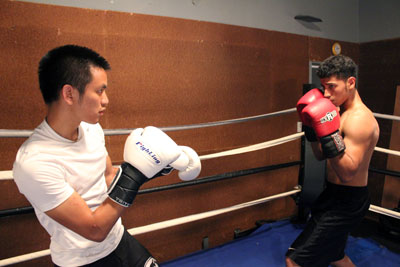
The circle parry is best used at long range.
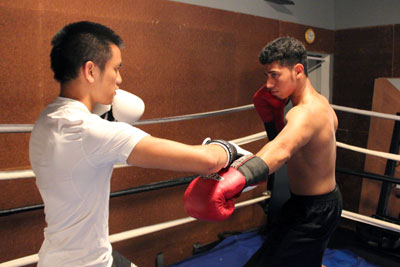
I circle parry the jab down and out to the side. This peels his shoulder away from his chin, leaving a hole for my straight right hand on the inside.
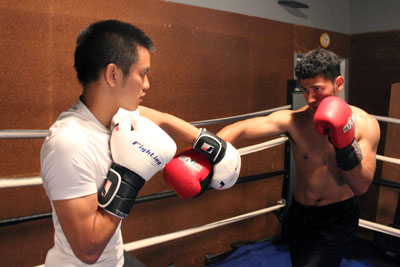
I circle parry the long right hand by deflecting his arm down to the outside. Notice the circular motion of my forearm around his (like two swords). I can easily circle parry all punches if he throws from too far.
Using the Circle Parry
The circle parry is easier to do if you float your hands in the air at long range, like a cat pawing the air. Try to counter with the same hand as the deflecting hand. Using the circle parry at long range can make it difficult for your opponent to get into range. At close range, you can use the circle parry to guide punches under your armpit and counter up the middle. Or you can also use the circle parry at close range to dig your parry arm into an under clinch.
Low Parry
To do a low parry, you swing your forearm down in a half-circle to deflect a low punch. It is commonly taught in many other martial arts and also quite effective for boxing.

Richard throws a low punch to my body.

I swing my forearm down sweeping the punch safely to the side.
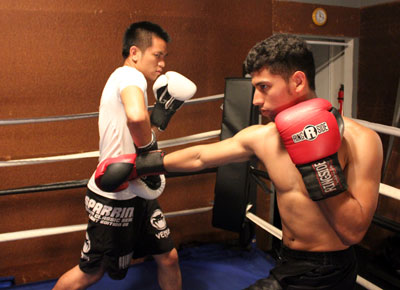
I can also deflect the punch with my other arm so I can move to the outside for a better counter or escape.

Down Parry vs Low Parry for low punches.
- The down parry deflects the punch into my balls or leaves me open if I get faked.
- The low parry completely sweeps the punch to the side.
- The low parry can protect against low blows where the elbow can’t reach.
- The low parry swings my elbow and shoulder into a more defensive position, leaving me less vulnerable.
- You can hit sweep the punch using your palm (like I did) or with the edge of your wrist (martial arts style), it doesn’t matter.
Using the Low Parry
The low parry is effective against low blows, which are too low to deflect using the other parry methods. If you’re taller than your opponent, you can use the low parry against all your opponent’s straight punches.
Once you master the low parry, you can do same-hand parries which means to use your right hand to low parry your opponent’s right hands and vice versa. Same-hand low parries will allow you to escape to the outside and counter with your free hand. It can take you a while to master this.
Parrying Tips for Boxing
Treat the Parry as a Shifting Guard
The best way to learn the parry is to treat it as an advanced block. Don’t make too much arm movement, learn how to block punches first and slightly shift into the parry. As you get better at reading punches, you can make bigger motions and guide your opponent’s punches further away from you. For beginners, I suggest keeping a tight defense and doing only SLIGHT parries.
Don’t Chase the Punch
Don’t chase the punch, let it come to you. Don’t let your hand get too far from your face. You’ll be vulnerable if your opponent throws a feint. Many beginners will slap down wildly and expose their head when I fake the jab.
Parry Straight Punches ONLY
Parry the STRAIGHT PUNCHES.
The parry technique is best used to deflect forward-thrusting attacks away from you. Parrying a looping punch like an uppercut or hook is very dangerous if it loops around your arm. Looping punches will always swing through; no parrying needed. Just get out of the way and counter after they pass through. Have a great counter that works off the parry? Open your gloves and show your face to bait the straight punch.
Don’t Parry the Small Punches
Remember that parrying is more effective against the bigger punches. Don’t try to chase down smaller punches unless you intend on countering. You don’t want to leave yourself open for a big punch because you were busy swatting at small punches. I like to block small punches to bait my opponent into committing a big punch.
BLOCK the small punches; PARRY the big punches.
Don’t Cross Parry
Don’t parry your opponent’s right with your right and vice versa. Cross parrying leaves you open on the side as your opponent attacks with his other hand. You should parry left-handed punches with your right hand, and parry right-handed punches with your left hand. You will also counter with the same hand that parries since your opponent is probably open on that side. (This rule can be broken once you get master parrying.)
Counter Immediately
Try to counter so fast that your opponent won’t remember your parry. Your want your parry trick to work the entire fight. Imagine your parry as the first punch of your combo; like (parry-2-3-2). Some guys admire their parry too much. They’ll ride the parry for too long and miss their counter opportunity.
Early Parry (advanced)
Once you get really comfortable with parrying you can relax a little more. You don’t always have to be so sharp and wait for a punch to come to you. The pros often hold their hands out to preemptively deflect punches as they move away.
You can parry before your opponent even throws a punch. Hold your hand out right in front of his to deflect his shot as soon as he throws it. It’s a clever move to control your opponent at close quarters. Sometimes I slap his glove down and punch right over it.
Switch-Stance Parry (REALLY advanced)
This is going to look like a bunch of kung-fu but bear with me. I’ve seen it done by many experienced boxers. The switch-stance parry means for you to move backwards switching back and forth from orthodox to southpaw as you parry punches. It’s a great way for you to combine footwork with parrying to give you better counter-punching angles as you back away elusively. (Plus, you’ll look cool!)
Here’s a quick demonstration of the switch-stance parry:
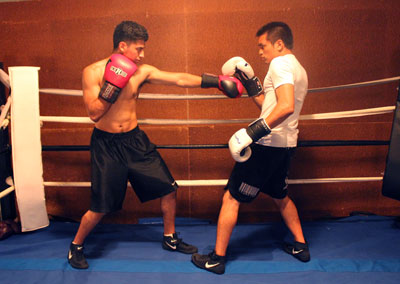
Richard attacks me with a high jab which I down parry.
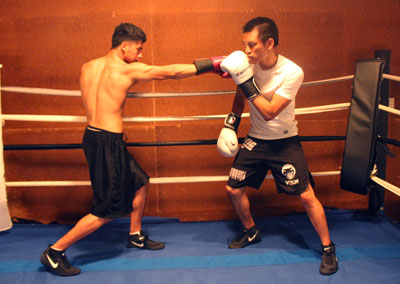
I step back into a southpaw stance deflecting the follow-up right hand with a side parry. I can counter with a southpaw left cross from here.
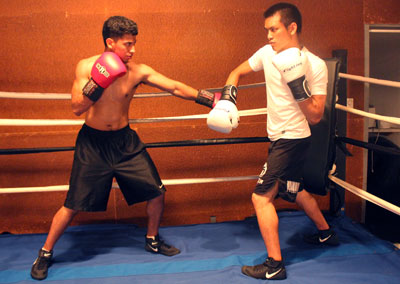
Or I can also back up again deflecting the next shot with a low parry.
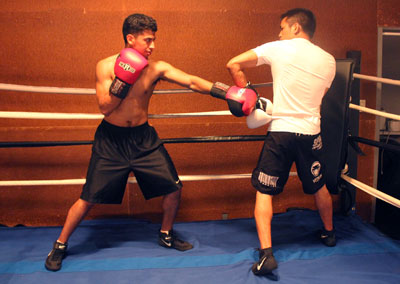
ALTERNATIVE: I low parry with my left hand instead of my right, which allows me to escape outside to the right.
Don’t wait to parry several times in a row, counter as soon as you can. I’ve seen guys switch stance 3-4 times in a row parrying entire combinations like a Bruce Lee movie. It’s insane. The examples above are just examples. You can parry any way you want. I recommend you not to try this until you’re super good.
The Beauty of the Parry
The parry creates openings in your opponent
using his own momentum!
The more power your opponent commits to his punch, the more vulnerable he will be. You’re taking advantage of his punches not by stopping them, but by guiding them off target. A quick wave off the hand deflects the punch and creates the opening all at once, while leaving your hand free to counter. It’s clever boxing.
Great boxers don’t block punches,
they avoid them entirely.
At the higher levels of boxing, it’s just not possible to block punches. Could you ever imagine yourself blocking a hammer with your hand? I wouldn’t either, and believe me, the top fighters punch just as hard as a hammer. Even when you see pros blocking punches on TV, they’ll still slightly parrying or rolling the punch. It’s crucial to learn how to deflect punches or avoid them entirely. Once you’ve mastered the art of parrying, you’ll naturally move on to slipping.
Ready to learn how to slip?
- How to Slip Punches (NEW GUIDE COMING SOON!)
- Old guide for slipping: How to Slip Punches in Boxing
- Also read my guide on How to Counter the Parry





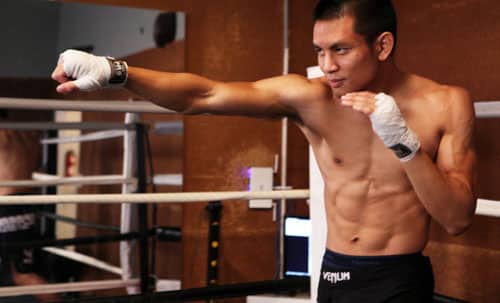
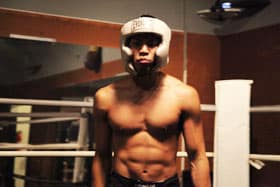
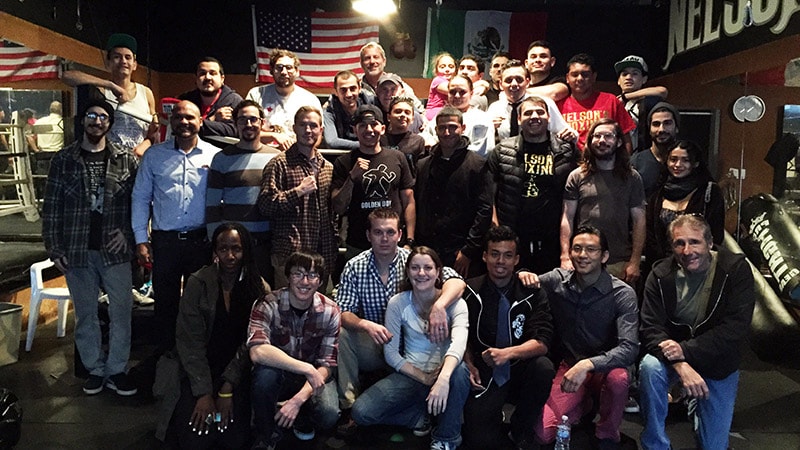
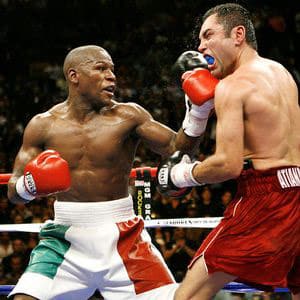
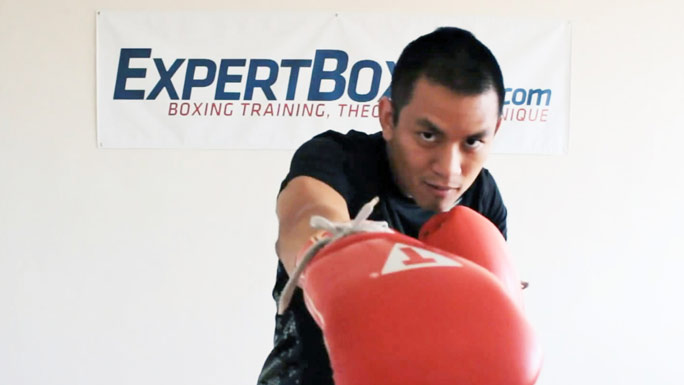

fedsd
thanks best article evre!!!
Nice work Johnny! I learn something new each time I go to this site. I never knew that there were that many variations of the parry. Keep up the great work!
Left Inside Forearm Parry
It seems that it would be hard to look over your forearm with the left inside forearm parry. Wouldn’t his fist obscure your view? Awesome article, by the way. I doubt I’ll ever be able to pull off the switch-stance parries. That is Asian martial artsy.
“The down parry deflects the punch into my balls or leaves me open if I get faked.” On that photo there is a very good acting 🙂 or i don’t want to think the other way that it hit you for real 🙂 Also when i first see that photo before i read the info under the picture i thought you make an Bruce lee screaming with parry 🙂
hi johny , thx for ur great article
a question : when the throw 1-2 at me ,, if i stay and trade punches in punches , i feel comfortable ,,, but when i just start to parry ,, it will be like : 1 – 2 – i’m gone ,, they just thrust with all the body and steping with the punches and always hit me with third ,, like left hook-upper etc ,, i just can’t counter after i parry the punches ,, any tip how to fix this ? any drills ?? when i want to counter after parrying ,, i find my hands far from my head when i want to start a punch and they will be so weak ( my punches ) and when they jump in suddenly after 1-2 ,, their third always land ..
FANTASTIC! The video is extremely HELPFUL!
this real nice im going to the gym and use this in sparring today
@Gordon – looking over the forearm is definitely possible…as long as you’re only trying to cover your chin and not cover your eyes. At high speed, there MAY be a split-second period where you are blinded but generally, you spin your body just enough to deflect the punch. The more skilled you are, the less you will have to turn.
@Radd – hahaha, the punch was not real. thanks for nominating me for an oscar
@mehran – I’m a little confused about what you mean. Do keep in mind that you should only be parrying straight punches and also that you should be countering as soon as possible. Don’t sit there trying to parry everything.
the side parry is dangerous
loved the demo of the asian parry thing coach cool. it really would be a proof of hand & foot speed, mayweatherlike move really. pac could learn it and mess him 🙂 and yeah the bruce lee-ness was awesome. coach i hate the side parry it is just awful against good opponents. orthodox-orthodox i cant tell you how many people good boxers fall for the fake jab-hook to the head and the body. its just not a good move. trying to parry they move that hand and boom usually the elbow. the right hand is just bad for parrying it should be near that chin whether youre upright crouch boston crab or ortho and if someone fights hands down guy who the hell parries from there ? the parry is the easiest to sell for the fake. i dont suggest a right hand parrying ANYTHING, jabs are often too fast, and the fake is so dangerous it gets the hand away it you said it no one should parry the hooks or round punches. the left hand i believe is best for jabbing, hooking. the left shoulders the best superfast weapon against a cross or a right hook. now if someone telegraphs a cross outgunning him with a body hook is better than trying to parry a blow that as you said can still glance you. and crosses are faster at their peak and harder to judge than jabs. a jab goes and comes quick but the cross starts slow and really raises in speed. we did a test practicing parrying jabs and crosses and jabs sometimes are too quick but they have a steady speed from say 1 foot out to 1 inch out. crosses suddenly change speed. have you observed this? pro fighters dont parry the cross unless they use a good boston crab like backup. and i believe the shoulder is more important as a reflex defense to a cross, a block can break your hand. and on a right over your left jab, theres no way to parry-but you can use the shoulder. anyone stupid enough to try and parry an overhand right with their right glove deserves to go down obviously.
the low parry i dont know why anyone would expose their solar plexus that way, just use the elbows and bend the knees, parry or block with those. elbow and wrist-forearm parries keep your hands in position moving your torso. they are what people make mayweather look so good called rhythm defense by some reporters. and they arent that tough to master. left wrist-forearm or elbow parry in, left hook or liver shot followed by a short right. even avg punchers can get a ko or at least a kd. left forearm or elbow parry out, right cross or backfoot hook-cut to the body or uppercut. right same thing, and even if you miss the cross or jab your hand is still in position to block a potential KO hook or cross. and ppl today think forearm parries to the chin cannot be done. they can, you just need to parry around the area near the wrist of the other boxer. easier for swarmers since our elbows are naturally higher and so are our wrists. there are so many benefits to forearm and elbow parries. ive seen one particular very soft puncher who LOVES to execute a left forearm parry, then grab the opponent’s right wrist and just right cross to the solar plexus or the chin. his lack of power is compensated by the counter speed i suppose. now if he had left side parried
loved the vids, i think the forearm and elbow parries to the body arent taught well to any boxers and right and low parries are just not efficient. maybe someone whos a boxer boxer like you understands the speed of punches better than guys i see but my experience left side parries to the cross come on too late, too early, and sometimes ive seen boxers fall so in love with left parries that they try to parry lead rights and are floored by a liver shot.
again my 2 cents. maybe im wrong or some of this stuff is `anti style ?’ im ready for being corrected if im wrong sensei..
@saber Khan – the side parry is really useful and can be made a little easier if you slip slightly to the opposite side as you do it. Different parries are easier for different punches depending on how your visualize the punch and the way in which you stand.
After reading what you said, I realize I had to update the guide with one small detail: treat the parrying as a moving block! When you first learn it, don’t try to be crazy and catch the punch with your outstretched hand. Just block it first but slightly shift your guard in the direction of a parry. Kind of like a half-parry.
In the low parry pictures, I exposed my solar plexus for demonstration purposes. You’re right, nobody would ever stand there like that. Nonetheless, it is still useful for sweeping away low punches. The low parry, similar to a side parry, is also easier to use if you’re already slipping to one side of the punch.
Parrying is a move advanced move and while it is riskier than blocking, it will allow you better counter-opportunities than blocking. If anything, parrying stands right between blocking & slipping…where slipping is the riskiest of the three but offers the most benefits. It’s also important to note that it will be difficult to parry punches if your opponent does not commit to any of them.
With time you will get better at seeing punches, and parrying them will be better than just blocking them.
amazing knowledge
I was blown away when I saw that was you in those pictures and videos above, I was expecting an older guy with a ton of boxing experience. You’ve got a talent for explaining things and the potiental to coach world champions. Keep up the articles I hang them in my gym for the other guys to read.
Thanks for the vid!
Nice video! This site has loads of very useful information for us aspiring to be good boxers. On parrying, my own experience is in line with saber khan. I came from a traditional martial arts background (karate) where we had to do blocks for each kind of strike. This was for the forms. But you could see that these types were useless in sparring as if you try to block something the opponent just times it or does a fake. All the new guys eventually realize that doing any active or specific blocking was dangerous to their health. I agree that its a high-level skill and I’ve seen top pros do it. (They parry down the jab mostly and counter with their own jab).
Coach, by any chance do you have any sparring or competition videos of either yourself or any of your mates doing these parries in a real situation? It would really help me get the timing down and see how you make it work.
Again, more power. We appreciate all the hard work that went into these videos.
Best peice on parrying I’ve read!
Hey man, thanks for doing all of this as it was very helpful and just comforting to know that the tecniques ive been training with would be helpful. I just have a question when you say that “parrying stands right between blocking & slipping…where slipping is the riskiest of the three but offers the most benefits.” I see how that can make sense, but cant parrying leave the opponent even more off balance than slipping if done correctly? and you could also chance grabbing the glove to slow them down more. Just a thought though. Also I was wondering about a simultaneous parry and head movement and how much more effective that would be than to just do one of them?
Thanks man, you were just in time…i have been looking good “parrying punches” guide and this is more than helpful 🙂
@sg – I was really touched by your comment. I think that was the best compliment I’ve ever heard and it means a lot. It’s flattering to hear that my writing is posted on the wall of a gym. I mean…WOW! Ok, I’m speechless. Thank you.
@JaketheSnake – Hey Jake, I was really worried when I read your comment. I’m always worried of not being able to communicate the technique clearly to the readers. If you’re not confident of using the technique, then I’m not doing my job right. I checked out my sparring videos as you asked but I noticed many problems. The parries are so fast that it just looks like my opponents are slightly missing. Only the low-parries look obvious. The other problem is that the parries have my style imprinted on them which is not what I want you guys to learn.
For now, I would suggest that you drill the parry movements I showed in the images and videos. Do them during a slow sparring practice where you mix in blocks & parries. Try not to think of the parry so much as a movement….instead treat it as a block but with a slight shift. This should get you more used to deflecting the impact slightly. Over time, you will learn how to parry the punch entirely. Please give this a try and if it doesn’t work, I will have to whip up some better videos for all of you!
i tried your parrying tips at sparring
Ive sparred last week with my instructor and tried your parrying techniques and ive got less beating than our previos spar. the problem is i parry so much like bruce lee and forget to counter immediately. I havent tried your advaced parrying tips the switching ones, but will try it.
I have several request
1.first is can you make a guide how to parry south paws
2.i had encountered the term “criss cross” from the anime “hajime no ippo” some time ago, its countering a counter punch. can you make a guide about it
many thanks
mingsy the cat
@mingsy the cat – yes, I should make a guide for parrying southpaws. For now, here are two most common parries I use against southpaws: down parry the jab and circle parry the left cross. Don’t forget to counter over the top after the parry!
sry, my last domment was confusing .. i read it again and its …..
what i was trying to say is when i parry a punch and goin to counter ,, his next punch in combo will touch me sooner than my counter punch … he’ll catch me first ,,,, then i’ll stuck in a chain of – he punches i block – …
@mehran
hey bro maybe i can help. if i got you right, you parry a guy throwing combos right ? alright so this is the thing:
1. he throws a punch
2. as you are parrying his next punch is ALREADY COMING
3. by the time you start to counter his fist is pretty close to you
4. and as your punch is halfway you probably have eaten some leather
i think you can kinda tell the problem. btw this is an opportunity to really learn some stuff because who youre sparring may either be a robit puncher or realises that you are countering late. here’s a solution not just for this guy but overall for how to counter
1. you dont parry then counter bro, AS you parry you counter at the same time. or you can decide to forget the parry and just counter the guy over or around his shot and beat him to the punch.
examples to make this clear (ive taken a vow not to be unclear on yet another post)
A COMBO PUNCHER WHO USES OPPOSITE HAND COMBOS
the first punch
left jab then right cross
left jab then right body hook (right body crosses are very slow)
left jab then right hook (only if hes really close to you)
left jab then right uppercut (only if hes really really close to you)
right lead then left jab
right lead then left hook
right lead then left body hook
right lead then left uppercut
the second punch
right cross (after a left shot) then left jab
right cross (after a left shot) then left hook
right cross (after a left shot) then left body hook
right cross (after a left shot) then left uppercut
so lots of combo possibilities right ? dont worry the solution is pretty much the same.
1. if he throws a jab and you see it coming
a, you parry with your right against his left hand and roll away from the punch AS you throw your left hook to his head (cuz you know hes gonna throw his cross or body shot right :D)
b. you just counter with an overhand cross over his jab (no parrying) while keeping your left glove up to stop a right cross and keep the elbow in to stop a right body shot
c. if he is SUPERFAST in his combos you parry his jab and roll away from the punch and immediately get ready to parry his right (dont forget rolling away from the punch) and on the second parry you throw your left jab or left hook-uppercut to the head or the digging hook to body
if its a right shot he starts with depending on his power you can parry it and roll with the punch, and at the same time you parry, throw your own punch as he is moving his left hand.
or you can block it (if he really gets great speed or power on that shot in which case i really wouldnt recommend trying to parry cuz he hits you-things are gonna go downhill) as you throw your punch.
so you got that bro ?
parry/block AS YOU throw your punch.
always ROLL AS YOU PARRY or block.
why do you roll ? well it decreases the sting of the punch as you block or parry, and just as important, it will remind you, you throw YOUR PUNCH AT THE SAME TIME AS THE PARRY. you dont wait for his fist to travel as you parry, you get ready to parry, start to throw your counter
A COMBO PUNCHER WHO USES SAME HAND COMBOS
left jab, left hook
left jab, left body hook
left hook, left hook (doubling on the hook)
left hook, left jab
left hook, left body hook hook (going up then down)
left body hook, left hook (going down then up)
same thing you block/parry as you counter with the opposite hand. the diff is ppl who who this have faster handspeed or great power and speed. if they throw doubles with one hand, your counter should hit that side cuz its exposed. it may be hard, as i said usually these ppl are super fast or may use a style like boston crab that naturally defend the left side. so if the left side is totally defended counter the space on the right side or the right side of their body with your left hand. i wouldnt suggest trying to counter over the top because ppl who double up are usually fast and accurate. if someone doubles up their right hand please teach them a lesson because theyre basically in southpaw stance and their entire left ribcage solar plexus its all open and you can whack them with a fast counter hook if you cant beat a guy’s double right leads with your left hook u need to work on speed.
if you do this stuff i guarantee youre not gonna have someone catch you with a combo as you parry one shot. they may try and feint you into opening up defenses but thats a more advanced level. i hope what i said made sense let me know if it was confusing.
@mehran – if you’re parrying correctly, he will be falling through the first punch. also, you should be countering immediately after the parry. you should also know that it’s very hard to parry someone that isn’t committing and pushing through his punches. If he’s a true snap puncher or just trying to touch you for points then you actually won’t have anything to parry. You’ll have to slip or just block. On the plus side, it’s nice to know he’s not ramming all his punches through you.
What Saber Khan said is also correct: if the guy is fast, you have to counter immediately or eat some punches.
combo punchers on whom the parry doesnt work
@Johhny N
i think what mehran means is he is parrying shot but the next punch in the combo lands before his punch coach. either the guy he’s fighting is putting little weight on the punch or not following through. yeah we agree on that. jabs even stiff ones when parried dont send a guy totally offbalance, unfortunately :S left hand straights do (where the foot thumps the ground giving the punch real power and needing the feet to be planted). unless someone’s sloppy with their jabs and pushing through, the parry to the jab doesnt unbalance them at least if theyre good. cuz they are going to start retracting so fast the lack of something to push against doesnt matter. again we’re talking on-balance snappy jabbers right ? guys who are on balance even if the punch misses ? a punch missing and a punch parried dont really change rhythm. at least a jab, and most good boxers don’t get too fazed if a power right is parried unless its a haymaker. im really not sure why a fall-through would occur…
as for countering after the parry, we were taught to counter as we parry. and maybe that’s because of my style but swarmers certainly dont have lightning fast hands in general. its pretty easy to counter as you parry as long as you can read feints. and if a boxer’s bad at reading feints he will be trapped in any combo puncher’s whirlwind eitherways.
i dont think pros or good fighters parry then punch, at least i cant remember any such punchers succeeding in trades that way. what i see all pros do is usually parrying, and the rolling and punching simultaneously.
did i get something wrong here ?
@saber khan – you’re right. the best boxers do punch AND parry at the same time. Some guys will parry with one as they counter with their other hand. Other guys do an instantaneous parry & immediate counter… example of this: with your right hand, shoot it forward as you tap down the opponent’s jab. So you think of your right hand making a quick bump before the right cross over his left arm. If you do it fast enough, it will look like a right cross counter, but in reality it very quickly (and un-noticeably) deflected the opponent left jab downwards just a tiny bit. If you watch Mayweather very VERY carefully, you will catch him doing it over his opponent’s left jabs.
I also remember southpaw Felix Sturm (then known as Adnan Catic) using the side parry beautifully against Jermain Taylor in the olympics. You can also see Kostya Tszyu using the circle parry beautifully against Vernon Forrest in the olympics here at 4:01 https://www.youtube.com/watch?v=RFqzr4oMwZM (btw, do you think I should link this video in the guy? I figured some guys might like it but I don’t want them to be biased by copying Tszyu’s style)
thank God i didnt get embarrassed
@Johhny N
yup coach, thats what i was going for, however floyd is basically doing something whitaker did, and before him sugar ray will pep before him and the master, jack johnson. today its a parry and then a counter. johnson invented a punch to the bicep, and then the jab. gans actually had it even more complicated with a parry outside and a jab while throwing the right hand just after the jab. but dont u feel thats compelx ? if u feel its okay hell im game!
now tsyzu is a master feinter, and feinting should be taught after ppl get their fundamentals totally grounded. i feel very hesitant sometimes id rather they mastered the stuff u suggest first. IMO this site is best for beginners, i mean featuring mayweather tsyzu roy jones SRL ppl of that sort shud kinda be at a different level. to me and you i think its natural, we wanna incorporate everything. but if ure asking my opinion, even the floyd and manny top 10 points went over most ppl’s heads i think. i just wrote again about the hook cuz amazingly, boxers are still doing the saaaaaame mistakes throwing the hook and asking `how do i get more power ?’
my opinion ? if u do decide to put up his vids coach ull have to really explain feints in detail. seperate the beginners stuff from guys who are intermediate, fixing bigginers’ errors stuff from the advanced stuff. start a bunch of work on advanced work-floyd, whitaker, roy jones, SRR, hearns, ali, pep, langford, jersey joe walcott, johnson, dempsey (i saw the qn on the dempsey roll and it wasnt totally accurate :-), tsyzy, forrest, pacquaio, JCC, hearns, naseem ahmed. we can discuss the weird things they got away with the techs used and such. but if its put in the middle of kids who dont know the fundamentals yet, and others who know the fundamentals but are trying to find a way to use it in sparring or fix little errors-i think it would confuse them big time. so yeah i think level 1 for beginners, level 2 for ppl fixing bad practices they picked up and learning how to improve conditioning, level 3 for ppl who have the tech and the moves but need to know how to use em, and maybe in a level 4 for those whove maximised what orthodox and classical boxing teaches them, a tsyzu and PBF and pacman and roy jones would be perfect examples. we could even talk about foreman vs frazier styles vs technique mosley vs forrest and chavez vs whitaker, duran vs SRL I and II and the mental aspects. things like roughing up inside, holding behind the head, the left straight punch, the feints and counter feints, defending within combos and fighting off the ropes a la rope a dope. so much to cover in this beautiful sport 🙂
hmm side parry…
@johhny n
coach read your response
`the side parry is really useful and can be made a little easier if you slip slightly to the opposite side as you do it’-> i agree, however the point of the side parry with THE GLOVE is a bad move. if someone like ali was gonna throw his left sure i would parry but if someone like trinidad or me or tyson was throwing the left, id be worried about the fake parry that would expose my head to a left hook. slipping helps, rolling is better. and it gives you a chance to throw your shot if he plans to use his combo.
`don’t try to be crazy and catch the punch with your outstretched hand’ ->i think thats pretty self explanatory but its good for ppl to be clear about.
`Just block it first but slightly shift your guard in the direction of a parry. Kind of like a half-parry’->well thats rolling into the punch, its also not a bad idea, i and other guys who had to deal with power punchers prefererred to roll away from the punch. but maybe that’s cuz we use a more boston crabbish defense, depending on the shoulder quite a bit so.. i agree, rolling towards the punch is better than pawing at it when someone feints. and even good fighters like floyd used to fall for the fake jab he’s fast enough to recover.
`The low parry, similar to a side parry, is also easier to use if you’re already slipping to one side of the punch’ ->You can parry with the elbows coach, If someone moved an arm independant of the body I certainly would make him pay and im damn sure a power puncher like a roy jones . but if he turns his guard in the rhythmical way whitaker jcc style it would push blows sideways and if it didnt block them and if it didnt make their sting much lower.
i kind of never found the parry a useful thing in terms of a hand moving out, but the entire body turning (which is a forearm parry or a body roll where the forearm or inside or outside of the elbow parries ot blocks the punch) does the same thing. the worst that can happen is ive lost a little bit of my side-on position, my hands are still in place in case im feinted and he decides to throw something else.
`Parrying is a move advanced move’ -> considering what you added yourself: `it will be difficult to parry punches if your opponent does not commit to any of them.’ u know well coach good natural punchers dont hit and pose with their hands on your chest like kara-tay, they touch the skin and boom! the shockwave goes through and while they’re halfway through the next punch.
`the low parry is also useful for guys who push at your hip bone. If you drop your elbows to block, they will push you off balance and so you must low parry to avoid getting pushed’
well they need to face some point elbow blocks breaking. old school roughhousing, using the point of your elbow to block the punch. this certainly isnt a sporting move but then we’re talking dirty tricks. you can also bob and as you come up throw the elbow when youre close to them inside. specially if theyre bigger, fast elbowing and catching punches on the points of the elbow can often injure opponents’ hands if they hipcheck. we follow the jack dempsey-marciano style, retaliate against bullies and it becomes a fair game. if one throws looping punches, we turned away from the punches so they either got `parried’ away by the elbows’ outside or blocked between the elbows.
most successful swarmers are counterintuitive rolling to catch the punch and bobbing instead of just slipping. the side of the forearm (just under the wrist) or the elbow while turning of the body is now called mayweather’s defense. before it was called the dempsey roll, and the JCC defense. i dont care what its called, my point is using the gloves to move a punch away is a bad move unless someone’s a hands down fighter in which case its better to slip. and im suggesting maybe, ppl should screw the concept of the parry altogether for the kind of defense JCC and floyd and whitaker and norton used not moving their gloves but turning the punch away. watch norton against ali, he knew jabs would land and ali would feint his ass off so he turns into the punches. however ali never went for the body with the jab much so norton can be a good example of just a left jab stopper. and if u watch all the fights, its obvious norton won at least 1 if not 2. he had ali’s number.
the one to stop uppercuts, that is really important. you can also try and point elbow block someone who throws a long uppercut. i think ali got nailed by frazier with the big hook on a long uppercut attempt. so i understand if u wanna stick to the `oldtime’ classics, just my opinion that the parry is more a theoretical than a practical tool..
@saber khan – thanks for the input. I’ll keep it in mind!
here comes the orthodoxy!
@dan
was that jab at me bro ? u think ive never been in a fight huh ? i wish my face looked like that. now i already stated these are my own views, views of a guy who was never that concerned with parrying. i was a bob-weave style swarmer, not that concerned with outside fighting. however ive seen coaches and their amazing differences of opinion:
`block the jab parry the cross’ while other coaches barked `parry the jab slip the cross’ and others `parry everything if u can’
can u tell me o wise dan which pro slaps away the jab ? jack johnson used to catch punches but it was blocking them downards not sidewards. larry holmes did it but downwards mostly on jabs and sidewards with the top of his elbows, or with the wrist area. just like i personally suggested. parrying downwards i said it was a good idea as long as the body rotation was there. but its amazing old timers just cant admit anything their coaches didnt teach them can possibly be right.
u probably saw guys like leonard in their prime right ? did he parry sideways the way coach for whatever reason showed in the vid ? thats what i was talking about. if u watched the vid, it shows the hand crossing the to the other side, without the body turning. the best guys at parrying i saw pro level or club level parried with their wrist areas, their forearms to push a punch to the side and turned the body to make sure there was enough power. just a fist to push a strong fighter’s right can lead to a boxer’s own glove hitting him id guess; its a cross it needs to be given sme respect pushed hard or blocked proper. i never said anything dumb like `block with your fist i suggested rolling the upper body to get power to push the hand without moving the gloves away from the standard guard.
did u check out the vid before cursing me ? johny N is great but pushing a cross with the left hand over the right shoulder ? and in the vid he’s actually slipping to the outside of the right cross that is ridiculous his hand shoud be free to throw a cross to the body or the head that’s a KO or at least a KD chance. ive never seen any normal boxer do this kind of parry, it seems dumb to me maybe ppl CAN do it but it seems like a waste and is openig up the entire left side the chin the body, someone who’s thrown a cross is close enough for a counterpunch the vid shows that opportunity taking arm totally out of the game. and believe me any good fighter will throw a hook with glee if they find an opponent whos chin and complete left body is defenseless. and say someone feints the right cross but throws it looping or overhand it will probably land even more flush to someone who’s slipping outside the cross!
still, maybe im wrong i admit i never `practiced’ lots of outfighting but i know all the moves cuz any fighter has to know what his opponent is capable of, if im wrong id like to know. just careful with your language bro this place is filled with lots of newbies id rather 2 old guys not fight and ruin it
@dan
oh just in case bro when i say i agree with the forearm parry i dont mean the one where the elbow has to move above the head, that kind of move that a good feinter will use. if i knew or any body puncher knew he could get an opponent to lift the left elbow to parry that way they would be feinting all day and night and land body shots and head shots as the boxer who tries to parry that way will expose some part of themselves. if someone does it to stop the jab by pushing it up i think any guy with a decent left hook will start mixing jabs with hooks, liver shots, throwing the half hook half uppercut. that comes at a 45 degree angle some call it the shovel hook.
and the circle parry ? please show me one guy who does that. its one thing to grab the pwoer arm but not like the way these videos show-i cant even imagine SRL or meldrick taylor or manny pacquaio pulling that off. grabbing the arm is one thing and its very advanced. its done with the elbow being inside the opponent’s bicep-forearm insertion point pushing it out from there and then can grab his bicep from the armpit while throwing the other arm. again how many times has this ever been successful as a defensive move ? its more of a clinch creating move.
a low parry is ok i suppose but if i knew someone fell for that i would feint all day. with an elbow block using the turning of the body, the ability to simply bend the knees, a good fighter can learn to catch shots as fast as with just their hands. and some low blows are just from really close there’s no escape. or one can turn and let them hit the hips, or intentionally get them to punch at the point of the elbow like graziano and basilio did (kind of like a down parry using the point of the elbow) check out old fighters how oldschool these tricks are but not that hard, dont waste movement you use the legs to move down no changing guard position or moving gloves from the face. or they can rough them up with the elbows like mike tyson when someone tried to low blow. of course these are only for one style, but im just saying the low parry isnt the only way. anyone can learn to use a good rolling defense and can parry as well as block with the elbows.
the `low’ parry actually looks a lot like a very weird overextended forearm block to the uppercut. ppl who uppercut well do it from so close using elbows is not a good idea, this low parry motion works well to stop uppercuts and often grab their hand if someone has come too far inside and one doesnt want to exchange. i suggested that the low parry be shown in terms of how the basic forarm perpendicular to forearm can be a block or parry to the uppercut.
@saber khan – I think he was poking at me considering I look young. I don’t get the troll comments sometimes. I wish they stated what it was they didn’t like. Oh well.
I think some people are really taking the parrying guide too literally. It is simply a technique being taught. Whether they’ve seen it used before is not the point. I’ve seen hundreds of pro’s parry and when it’s done right, you can’t see it but you can feel it. It’s there. I don’t make up the techniques. They’ve been there hundreds of years before ExpertBoxing and will be there long after ExpertBoxing.
As for the validity behind techniques like the circle parry. You can watch the Russ Anber video in the Title Boxing series where he demonstrates his verysion of the circle parry. Some guys make it a full forearm wrap. As for me, I think of it as a much more technical parry. What I do is sneak my hand to the INSIDE of my opponent’s wrist and flick his wrist (and thus, the entire arm) OUTWARDS with my fingers. It’s so subtle that you cannot see it, but you can definitely feel it. A pro did this to me many times and taught me it because of how useful it was. The downwards parry only slaps the punch downwards but the circle parry slaps the punch OUTWARDS…thus making his hand split to the side an extra few inches so that you can punch straight up the middle.
As for the side parry…again, this technique is used A LOT. Go to any gym full of pro’s and step in with one. I am most definitely sure that they are using it. Not all of them will use it in the same manner of my style (which is with a slight slip) but they are definitely doing it. They’re doing it against jabs, right crosses, left crosses, etc. Of course I added mine with a slip because it’s my style. Other’s might do it with a bobbing head movement or side step. It doesn’t matter, the side parry technique alone will not with you the fight…you have to combine it with…”fighting”. Look at the jab, just standing there and jabbing is not going to win fights. You have to combine it with footwork and follow it up with other punches.
Most people have this idea that if you don’t a pro using a technique, it’s not useful and therefore unrealistic. The thing is people don’t have the eyes to see it. If somebody was a total noob and only watched a backyard street fight, they might say the guy with the wide swings is a more impressive puncher than the guy with the straight punches. They don’t understand where the power and technique comes from. I would say the same to people who’ve never seen certain techniques. It is VERY DIFFICULT to see a technique if it’s never been taught to you…that’s where I try to come in. (with resistance every now and then) But if you choose not to see it and not to try it, understand it….it is your loss, not mine.
All I can say is that you have to try the techniques. It is very common that throughout the years, popular boxers will come and go making their fighting styles popular because they were successful with them. After Mike Tyson, WAVES of people were begging to learn the peek-a-boo style. After Floyd Mayweather, everybody has a video on youtube copying the same padwork. If you want to be good to yourself, develop your own style. Who knows, you might create the future. Unseen, unpopular technique has always been known to shock and dominate popular styles on the years because of people’s blindness to the style.
I’m not busy mastering anybody’s style because I have my own and I love it. It’s made up of small pieces of other fighters’ styles and more importantly a very big piece of my own personality. It may not be perfect but it’s how I want to move and respond to situations. When I speak, I want to use my own words…and when I fight, I want to use my own style. The biggest joy in my life is when fighters come up to me asking me to show them MY STYLE (not mayweathers/pacquiao/etc).
@Johnny N;
Quote “If you want to be good to yourself, develop your own style. Unseen, unpopular technique has always been known to shock and dominate popular styles on the years because of people’s blindness to the style.”
Quote “I’m not busy mastering anybody’s style because I have my own and I love it. It’s made up of small pieces of other fighters’ styles and more importantly a very big piece of my own personality. It may not be perfect but it’s how I want to move and respond to situations. When I speak, I want to use my own words…and when I fight, I want to use my own style. One of the greatest joys in my life is when other fighters come up to me asking me to show them MY STYLE (not mayweathers/pacquiao/tyson/etc).”
Perfect statements. One of the amazing thing in boxing i guess it is open to very different styles and techniques. But also there is a lot of guys and coaches in boxing who wants to impose their own style to everyone. These people think that their style is only true and must and they don’t have a open mind to new styles and techniques. I guess everybody’s physical structure, mental structure, body mechanics, fight mentality can vary. So the styles and boxers vary. That’s the beauty of boxing. Just because one technique works on a person doesn’t mean that can work on everybody or vice versa.
You always mention on your answers and articles “do what works for you” and that’s one of the reasons why i follow your articles and have a huge respect for you. You have a open mind. And finally about the age “intelligence is in the head not in the age”. I saw empty guys at 60 years old and i saw 18-20 years old guys with wisdom.
there’s unorthodox and practical, and then there’s unorthodox and practically poor
@johnnyN
check out my answer coach. i think he was potshotting me but anyway we’ll see when if he does come back and post something.
i was commenting on the way things are shown in the 3 videos. now im not a big thinker in boxing. you are for sure, and i give u props ALL DAY. boxing was a way to earn money for me, keep my father from threating to kick me out, to vent off steam cuz ppl couldn’t stand me (probably still can’t) but i didnt want to go to jail. but thanks to boxing and what it taught me about life, the financial support, the way it made me a man, i got to be a pretty successful doctor:-) and im happy someone so wise at such a young age is teaching kids free, just cuz he wants to 🙂 so all props to you coach.
my first 4 fights, i was 1-2-0-1NC. no one taught me the ropes till my friend sam came along. after THAT i had 33 wins, i think my missed only 2 KOs amongs those bouts at middle. cruiserweight screwed me but that was mostly the fact that my reach sucks. thats why i keep harping on how lucky these kids are.
i read in some book, boxing is about:
1. putting your options against the other guy’s options so it comes out beneficial for you
2. eliminating being hurt while hurting or trading a chance to get hurt for a chance to hurt harder (off-def or def-off)
3. being able to successfully use opportunities to hurt and doing it as hard fast and many times as possible
4. knowing how to stay in the game even when being hit and having the mentality
vague crap. sam taught me to understand range and position, opportunity, timing, accuracy, being economical. color it anyway u want boxing is a chess match where some physical attributes can help overcome others, and some are useless. being able to jump doesnt help. long arms, speed, a great chin and resilience, endurance; they help make somethings possible that otherwise would be impossible. but using them the wrong way is never a good idea.
ali was fast in his prime, had long arms, a great chin and endurance. he understood some elements of the game but didnt understand a lot. he wasnt an accurate puncher, he was sloppy and made up with volume. he wasn’t economical moving his feet until later in his career. he didnt understand the range, position, opportunity and timing he gave opponents by leaning back, keeping his hands low. he leaned back-it worked for him. but if any HW of his day had the ability to feint and punch, i think ali would have been permanently injured. because he kept his hands low and couldnt even block a slow like norton. if foreman understood economy and opportunity ali wouldnt stand a chance against him.
the circle parry as in the video gives the other guy the range to hit with the other arm and puts the gloves way out of position. the timing and accuracy required to pull it off would have to be incredible against a fast cross or a jab. it provides the opponent opportunity to hit with the other hand because both are tangled, and if one misses then that side of the body is defenseless. and it gives the boxer no great opportunity because his hand is now elbow out and he has to shift it back to throw any punch, by which time the opponent can recover. its uneconomical, the glove is dipping below guard position and the elbow is going far out.
instead the forearm parry towards the outside rolling the shoulders to provide the power does the same thing. it stops the fighter from having the range to hit, it gives a fighter range to throw his own hand, the timing and accuracy are easier than the circle parry showed in this video which resembles a karate move more than anything. range & position, oppoerunity, timing, accuracy and economy are better doing the forearm parry. what you described verbally coach:
`sneak my hand to the INSIDE of my opponent’s wrist
flick his wrist OUTWARDS with my fingers
slaps the punch OUTWARDS
you can counter straight up the middle’
this is economical, it keeps your range and position while taking his away, its timing and accuracy are easier, and provides opportunity to throw a counter.
the video is not demonstrating this at all. elbow goes from down to up and then spins? ppl have difficulty down parrying a good jab!
there’s unorthodox and practical, and then there’s unorthodox and practically poor part 2
`The up forearm parry…Manny Pacquiao uses this’
and every power puncher with a brain groans when they see it. ali did it to foreman. shavers. sugar ray leonard did it and buster mathis did it. doesnt make it a smart move just a move that works against dumb boxers throwing full force telegraphed punches. its giving range and position away, its timing and accuracy doesnt look bad, but it creates opportunities for the other fighter to feint and its uneconomical. forearm parrying upwards is a last resort move created by lightweight benny leonard, u can see larry holmes use it. if he was jabbing and someone was throwing an overhand he would sent the left forearm of that hand up to stop the overhand shot. its a last ditch thing. a good move and one could say a far more useful parry to know (although more advanced) than the 60s’ upwards parry.
`The side parry. doing it against jabs, right crosses, left crosses
I added mine with a slip because it’s my style
Other’s might do it with a bobbing head movement or side step
pushing with their knuckles instead of the palm
pushing their opponent’s forearm/elbow instead of the glove
the side parry technique alone will not with you the fight…you have to combine it with fighting’
What is shown in the video could just be done as a standard slip to the outside. And if one redirects a power puncher’s hand that way it will hit him in the face unless he slips or rolls. You cant just parry like this without turning the chin away coach. Pros rotate the shoulders to put power into the wrist where the tapes are and pushing the punch to the side. Others shoulder roll and block. We slipped. The standard parry no-name ppl teach at boxing gyms is just slapping with one hand, which is probably useful against the jab without the shoulder roll (though its more economical just blocking the punch or rolling the shoulder) . The `side parry’ as shown in the vid-if you didnt slip with it wouldnt it just smack you partially on the right side of your chin ? You HAVE to slip to get it over your shouder. So if someone is parrying this way and slips wrong or a bit late-its just leading a fist into the face. to make sure there’s power behind the parry the torso needs to help IMO. it keeps range and position, its just as economical, creates opportunity without giving even the chance of any (if the wrist misses the shoulder covers the chin against the right), timing and accuracy are easier to master than the slipping AND parrying at the same time.
and a gifted guy can do crazy things. things like ketchel’s hook where he would land the punch with his thumb and KO opponents, ali’s leaning back from punches, roy jones’ head leaning for the left hook, dempsey’s low left hand before a hook upstairs for more power, louis’ low left hand after throwing a jab, trinidad’s raised right foot, foreman’s wide looping punches-u know i could go on and on. why not make lamotta/hagler/margarito’s chin defense a boxing technique ? i think one shud know that stuff can be done but be taught to do what fit the fundamental boxing requirements: stuff that the masters used. guys like SRR, benny leonard, joe louis, gene tunney, 80-88 mike tyson. as well as exceptional things that helped a person’s individual skill. if someone can do it, they should. but the basics should be the stuff that stood the test of time or seem to have emerged recently and been just as dominant.
thats why i said some stuff is more dangerous, some more economical, etc and the parry should just be exchanged for the slip roll and block and be kept as a last resoirt.
cuz as one’s opposition gets better parries are useful less and less except as a last resort
a few other things, stuff i remembered ill write em before i gotta check my jr’ pre-ops:
a parry that pushes the puncher’s hand outside can be done with the glove or the wrist and its a very small efficient movement. its called an outside parry. u mentioned mayweather he does this and the downparry and the inparry and throws the right with the same hand in a split second. the reason is because of how little the guard has to move when one rotates the body and gets used to rotating the body and using the hand as an extension of the rotating torso. to get space, just outside parry with the forearm or the lower part of the glove depending on how how high your guard is-circle parries aren’t needed at all. unless one wants to tie up the arm.
another way to get a puncher’s arm to move outwards and actually paralyze it for a half a second-this is very advanced but since u wanna talk advanced-punch at the elbow. i was a swarmer but i was stunned by this when throwing a lazy hook and i couldnt believe how totally flaccid my arm felt. amazingly short punch and you have total freedom to kill the opponent with a hook. the bicep punch by jack johnson is a generalization of this, oldtimers talk about it but ive seen tried it and it doesnt paralyze like hitting at the elbow joint. the bicep punch is also further out, but all 3 move the opponent’s punching arm further out. and none compromises the guard.
the forearm up parry is done that way by pac ali etc because its a desperation move. im guessing where pac learnt it, ali did it to foreman in zaire and frazier in manila and its because he kept his hands low. he also did this `parry’ with just his glove sometimes. pac does it on lazy punches far off punches however its something one of many that probably drives freddie roach nuts. where did ali learn this ? problably benny leonard cuz i know for sure leonard did it cuz we saw footage of leonard doing it. but where leonard got it is most interesting, and hearsay. some oldtimer who liked to watch benny practice talked about how benny was like gans and how gans did things including parrying upwards with the elbow. and benny in some fight was being countered over his jab, and he suddenly began throwing his elbow up when the right counter was coming over his jab. and it sent the other guy’s right hand flying and he could jab. while i know benny did it the story that he just suddenly figured it out in the middle of a fight, off something someone told him a long time back is maybe apocryphical. but ali did it because he kept his hands down, sugar ray leonard pac they do it for the same reason its a last ditch effort to stop a hand from landing when the guard hand is low. thats not something worth teaching is it? worth knowing sure but i wouldnt teach it to anyone except a hands down fighter. i would certainly teach the benny leonard verson. LARRY HOLMES DID IT RIGHT! yep i just remembered holmes was a sparring partner to Ali and he used to throw his elbow up to stop a right counter over his jab. i would teach that move to any boxer though they may never have to use it, like if they prefer to hook rather than jab to start their offense.
i know i bitch about my coaches but i cant ever say they didnt tell good stories. and they talked a lot about the stories they heard when they were young of guys like benny the brain and rocky graziano and basilio and sugar ray and ezzard charles jersey joe walcott. i gotta go but i hope i explained why in my opnion these 3 parries are not the best options coach.
@saber khan – practical vs un-practical. good technique vs bad technique. Somewhere in the essence of the technique lies what is useful. I teach it because I’ve seen so many fighters that use it. I’ve fought many fighters that all used those forms quite effectively and I try to teach it in the manner that I’ve adopted from them. I don’t recall how the old time greats did it but I do recall how my opponents did. Quite simply, I like the move. It’s effective, it works, it may not be the absolute best defensive move but it’s effective enough to be taught. Sometimes it feels like a moving block, other times a deflected blow, and other times a bit like a hand trap. Oh btw, I exaggerate the moves in my videos and pictures, moving a little more than necessary to help people understand what the motions are. In there pictures where I didn’t move as much, you can hardly tell in what direction I’m moving my gloves, looks more like a block than a parry, etc.
Great site and insights!
Just found this site a couple of days ago and I am very impressed and extremely grateful.
I found the instruction of Johnny N. and the personal insights and pro fight experiences of Saber Khan, to be so incredibly useful, extensive and influential, that I had to write in to express my appreciation.
Having loved the sport of boxing since I was a kid and watching The Greatest – Ali, on Wide World of Sports, I have to thank both ‘Coach’ Johnny N. and Saber Khan, for helping to educate me and I imagine many others, in grasping a firmer understanding and stronger skill set of the ‘sweet science’.
The two of you really do make a spectacular impression – THANKS!
On a more personal note, I’d like to learn more, because I recently took up kickboxng classes, at 49 years of age, for improved fitness and health reasons.
Boxing however is far more interesting imo and I have reworked my basement into a home gym, with a heavy bag, double ended bag and weight set to help me lose excess weight.
I feel as I get older, I really do need to be in better shape and my heart and mind are stimulated alot by pursuing boxing ‘science’.
By learning as much as possible, I can teach my 3 God-sons, because I want them to know of the character and esteem building benefits connected with good physical fitness and disciplined training. Of course, the self defence aspects are also very important for youngsters 9, 15 and 17 and later this week, they will be attending their first classes.
Gentlemen, please continue to keep up the good work and sharing of your boxing knowledge, because this website and your combined insights, are in one word – FANTASTIC!
Peace.
What is a ‘boston crab’ style and what is ‘swarming’
@Saber Khan….As a newbie, I have a question to ask – What is the ‘boston crab style’ and what is the ‘swarming style’ you speak of?
Thanks.
@King Lion – thank you very much! we are both honored to have helped.
@King Lion
damn im sorry dude, i have a bad habit, we always call the philly shoulder the boston crab i mean the philly shell, the way floyd mayweather and james toney use their left shoulder to cover their left side of the chin roll with punches to their left and keep their left hand free of blocking duty 🙂 really sorry. its just something we developed in our gym to use `code names’ for stuff we found funny (a crab boxing with one claw up and one down 🙂 so yeah `boston crab’ is actually something else, its some wrestling move-but when i use it its just MY stupid code for the philly shoulder stance and shoulder rolling defense. thanks for pointing it out. btw not a bad tactic in the ring to refer to stuff your sparmates never heard of u know, play some mind games with them too 🙂 i think i refer to other stuff in weird ways too like the left jab-lead or jab-straight or jab/cross (all of them are the same thing, a jab but u put all your weight on your front foot as you throw it, it is much harder than the jab as good as the avg cross and a good variation on the 1-1 or normal double jab or you could triple jab this way with the normal double jab and this one with mustard on it.)
the swarming style, its one of the 3 central boxing styles. these fighters’ philosphy is always moving forward, pressuring, and throwing lots of punches. it also employes (though not ALWAYS) a lower than usual position so the fighter can get inside longer armer opponents. and most of these fighters go to the body more than any other style.
its primarily used if a person: 1. does not have enough pwoer to be a slugger or 2. has shorter reach for his division despite the power, to be a boxer or a slugger.
4 main types. there’s the crouching swarmer with the head forward, coming forward, throwing lots of punches, like tommy burns, jim jeffries, rocky marciano, carmen basilio, mickey ward, even manny pacquaio in his middle stage of his career (when he fought ledwaba, barrera etc). no particular defense they employ but they will duck some, slip some-but with no particular emphasis. all they want to do is get inside and trade
there’s the standing swarmer, same thing comes forward, throws lots of punches, mentally fatigues the opponent. but they stand straighter because they have good chins and usually are taller. a battling nelson, jake lamotta, harry greb, henry armstrong. in today’s era hatton, margarito. usually have some power, an amazing resilience to being hit, and lots and lots of stamina.
there’s the mexican swarmer, the diff is they have good guard position, their head isnt hanging forward and they have really good blocking and slipping while moving INSIDE. and the mexican swarmer first works the body tires out the opponent then goes for the head. their infighting is usually exceptional, they can block punches and punch by sometimes nothing but a vague impression of where the opponent’s fists are. they love to work body and then the head. they will take a few shots if they have to but break down their opponent, the king was chavez, with guys like barrera and so many others emulating him-diaz, etc.
there’s the bob and weave swarmer. which is a swarmer who moving forwards from a low position with the head always slipping side to side, never letting a boxer have any place to aim. terry mcgovern started it, jack dempsey’s roll was coined for his version of head movement, and others evolved the technique. u can also see joe frazier. these fighters do well in the clinch or inside fighting. the bob-and-weave swarmer is like the other swarmers a move-forward, high pressure fighter but usually not so much a volume puncher. they need to go to the body and head from both sides but they’re combo punchers and need to have a powerful left hook both to the head and body, btw floyd patterson, mike tyson particular use a sub-style within bob-and-weaving swarmers called peek-a-boo style involving really high glove guard position. however it doesnt have good infighting skills to prevent the clinch.
some say miguel cotto is included among mexican swarmer styles-well he does like to pressure and move forward and hit the body but he wasnt a mega volume puncher and could lay back and become a boxer-puncher if he needed to. he’s more like a joe louis or felix trinidad. u can see ricardo mayorga always moving forward and throwing punches but he’s a slugger more like foreman, aims to finish with one shot. pac is anoth exception-he was a slugger at fly, a semi-swarmer at feather, and now he’s a boxer puncher who can swarm if he wants to.
so that’s the swarmers style, odd outliers still exist obviously (like cotto and pacquaio and me i believe 🙂 but i hope it was relatively clear.
Wonderful explanation. I doubt there is one single person here in Germany who could do likewise. A few will know what kind of fighter a “swarmer” is. But no one could tell you that there are different swarmer-styles!
i poop
@KingLion
and thanks for your remark bro very happy to have contributed something useful 🙂 and i hope no one copies my little bad habits, im not that good at explaining boxing like coach Johnny is as u can obviously see 😛 but im trying to improve the clarity of the stuff i talk about
oops yet another correction 🙁
@KingLion
one more little thing-the true philly shoulder roll is a guard not a `style’. its a way to hold your hands, what angle to keep your torso at. the right hand is up, the left side of the chin is tucked into the shoulder which is turned to 1 or 2 oclock from your viewpoint and the left hand is down.
as i said, the boston crab is our stupid name for the philly shell. but what we meant by it, wasnt the standard philly shell. in our modified philly shell, the shoulder-chin tuck exists but the shoulder is at 12-1 o clock and the left hand is UP in guard position. kind of a mix of the CONVENTIONAL and philly guards. it gives you easier shoulder rotation guard against the right orthodox cross as opposed to the normal stance or the conventional bob and weave stance, the opponent’s liver shot is harder for him to land, easier for you (your left hand is closer to his left and right body and his left hand is closer only to your left so u have to keep tha hand up). your left hook is strengthened and it’s an odd modified stance boxers don’t normally see. you’re more side-on and he appears more square compared to you. it’s a variation for a boxer or skilled swarmer and we used the name cuz it reminded us of a crab on the beach who was fighting another with just one claw basically and moving diagonally almost like a philly shell boxer. shell=crab, u know 🙂 yeah we were pretty dumb when we were young.
the true philly shoulder guard with the hand down is bad for fighting southpaws, watch floyd he goes to conventional guard against lefties. toney sometimes. in the middle east there are more than the statistical 1:9 southpaw boxer. (13 pro southpaws in just the middleweight class-unlucky number unlucky playing field for many guys but i loved fighting southpaws). the normal philly shell guard makes the left side of the body much more exposed, and i am never a proponent of keeping my body open to anyone’s shot because body shots drain energy and power much more than head shots. plus we had only 2 guy in the entire country (UAE is a small country) who were pros fighter using the real philly shoulder stance. one sucked against southpaws and those who feinted well, and one just sucked period. and not one winning trainer/coach who understood the intricacies. so obviously we didnt have anyone to teach the high level moves, or anyone from who we could cheat those moves from without hoping to emulate being beaten to a pulp.
this modified stance was a good mix of the philly shoulder rolling and the conventional stance,
there is so much the half-shoulder roll guard half-conventional guard allows you to do. for one, no one else even noticed it!)its simply not something anyone uses. its more dangerous to an orthodoxer than an orthodox and to a southpaw than another southpaw. and it has various benefits for people trying to close distance against tall fighters who jab into the chest or throw long right leads. the weakness is that those who made it and used it had to practice a lot to remember and have the endurance the shoulder tucked and the hand up (it’s draining to do both). we had to go maverick in many ways and learn by seeing and modifying weaknesses by sparring. and being beaten up and then going ok what did i do wrong there ? and tell each other (lightweight, a featherweight, me, and a lightweight from another gym shared out secrets). no coach johnny for us kinglion 🙁
and like i said if u do wanna play mind games, an important part of fighting IMO, use weird names. do things a little differently; learn to feint, and if u can land a shot once u feint him out stop short. smile and dont feint for a while it will do amazing things. he will feel stupid, slow, like u can hit him, and when u do hit him (cuz he will think u are maybe feinting all the time) his belief that u can hit him at will go up. he MAY refuse to spar against u 🙂 feint with the left hand up and go down, feint a jab and throw a hook, throw a full jab the next time, then feint with your left hand and throw a fast soft right lead. and say to yourself `damn i have to throw the langford shot with more twist’ or something just as cryptic. u like ali? play mind games bro like ali. when he throws a cross, pivot off your your left foot towards your own right, turn southpaw suddenly and bang him with a weak right hook and clinch immediately and whisper in his ear `youre lucky i havent bruce lee eardrum bursting punch in a long time’ in a friendly voice.
thats the kind of mind games that will drive opponents nuts and you dont even have to be good at it, just doing it will have them thinking u know a lot more than anybody could.
The honor is mine….really!
@Johnny N…..Coach….I want to thank YOU for everything this site has taught me – so far!
I got your 5 Biggest Boxing Mistakes pdf today and can’t wait to give a copy to my Godsons when they come this week.
Good stuff, man – thanks again!
@Saber Khan….Thank you for the quick response and detailed explanation…..WOW…..I can honestly say this site truly has a great wealth of information.
I am not nearly as informed about many of the fighters you mentioned, but can relate to the old days of Cassius Clay, George Chuvalo (who is from my home town of Toronto) – Ali and Frazier, Norton, Foreman – Leonard and Duran – Hearns – Aaron Pryor – Holmes and of course Tyson, but I grew weary of boxing after the ear biting incident.
Now cats like Berto, Manny, Froch, Amir Khan and of course ‘Coach’ Johnny N, his website and yourself have helped to pique my interest again…..Nice!
I have to tell ya, Saber Khan, when you ended that last post with the ‘mind game’ approach, I was blown away and laffed my azz off when you described the ‘whisper’ – Very Cool!
Thanks.
thx johnny , thx saberkhan ,, a lot
:cry::-*:P8):o:sad::sad:;-):D;-):-):-);-):D;-):sad::sad::o8):P:-*:cry:
Great directions!!
I’m getting back in to muay thai after 8yrs off due to been lazy and getting fat lol. the one thing I have found is that I read the punches right I just cant get my hands there quick enough. Plus like in most gyms we tend to work on attack more than we do defence which is key. I’m really going to practice the technique’s on this website
From a Parry learning to Parry again !!
can you perry a punch with your head? or not?
You can deflect a punch with your head by turning it to the side.
Hey Johnny,
Thanks for giving us the best pound for pound boxing site on the planet. I just wanted to know, who are your top 3 Parry experts in boxing? Who would say employs the move more than anyone else?
Great question, Roey. I notice the guys using the parry the most are either the really tall or really short guys. The tall guys parry because they can’t slip fast enough, and their arms are so long they and leave their gloves out there without fear of leaving their face open. The short guys parry because they can’t slip into range fast enough, so they deflect shots while wading in.
With that being said, I really like how Prince Naseem does it. Also many heavyweights parry, especially the old heavyweights. I remember Lennox Lewis doing it a lot, too.
can i parry with my elbow to knock a straight body shot off course?
You definitely can. Standard technique.
Thanks a lot Johnny……Good Article and your techniques have helped me out not only in boxing but in my
Martial Arts practice also……Great Work…..
Hey Johnny,where should I focus on the opponent’s body when I have to parry his fast incoming punches……Please Answer……….
I don’t understand your question. Maybe my video can demonstrate better for you?
how would you apply the inside forearm parry as a southpaw?
You can use it against really straight punches like a jab or cross but that’s about it. When used against arc’ed punches it becomes more like a block than a parry.
Amazing article ! Extremely helpful !
But I am intrested how much and how long I schoud practise parrys in my boxing workouts(I workout almost every day)?
A few rounds or so everyday will be plenty. Doing them in sparring will help the most.
Hey I love this article but I was wondering if it’s okay to parry a jab with your left hand then immediately shoot the jab over it I do this move all the time and it works great in sparring because I take away his jab while in return establishing mine but can you think of any holes this type of parry would have so I can keep it in mind when I take on tougher fighters
That tactic works fine, you just need to worry about him coming in hard with his right hand while your left hand is occupied with the pity-pat battle.
Hi Johnny , do you watch Hajime no Ippo and name some anime that you watch.
Would t it be best to parry and counter with the other hand simultaneously
Some cool new tools to add my arsenal here. I was already using parries, but now i see there are better and more efficient ways to do them, that should improve my effectiveness at deflecting those blows. Impressive how much advanced techniques we can find on this site.
Isn’t it best to parry and counter simultaneously
What if it is a Southpaw vs Orthodox matchup. Then you would have to counter parry? All you would be doing is cross-parrying?
thank for the teaching
these techniques don’t have to be used of you’ve mastered the shoulder roll correct? @Johnny N
While you might not prefer them, I can assure you parry techniques will be useful even if you’ve already mastered the shoulder roll.
Hello Johnny
Good article, thankyou, I always seem to learn something from reading boxing books or articles like this.
I would like to add a comment from my experience in boxing though, in response to your comment above and quoted here:
“Could you ever imagine yourself blocking a hammer with your hand? I wouldn’t either, and believe me, the top fighters punch just as hard as a hammer”.
In my humble experience I agree with this view, I was a middle weight, very fit, strong, healthy and capable and I sparred with light heavy weights at my ring. One became a national champion. L.H weights are hard going for lighter fellas as people now. My technique was correct and well-practiced.
I often parried their straight punches for practice and fun but being powerful fit people they threw them like sledge hammers as you say; just to see if I could deflect them. I found I needed to parry them with way more force than I previously thought necessary. Easier with people of my weight division.
If the L.H. weights threw them full force I need to parry them almost as hard to move the punch off the straight aim. In other words I needed to practically ram them off their aim.
My experiences showed me that when faced with a bigger stronger opponent who is fit, the parry is only a little better than the block. It is better to practice up the various types of slipping than rely on the hand movement defences including the parries. As you mention a lot of pros move on to slipping.
Having mentioned this it is also my observation that hand movement defences are worth learning and using and including in our boxing; but the slip is better.
Kind Regards
Fantastic, blocking in boxing made easier!